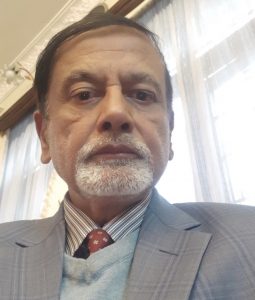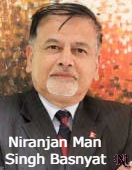“According to the World Bank, middle-income countries (MICs) are defined as economies with a gross national income (GNI) per capita between $1,036 and $12,535. The GNI per capita income of Nepal reached $ 4230 PPP in 2021. Thus Nepal is one of the MICs”.
-Dr. Niranjan Man Singh Basnyat
Kathmandu, Nepal

Abstract:
This article aims to shed light on the challenges of global warming and climate change. The disasters produced by such phenomena are impacting the lives of people inhabiting the mountains, hills, and Tarai areas of Nepal. It also explains how to safeguard our ecological environment and mitigate the effects of global warming and climate
change. Similarly, it also elaborates on how Nepal can face this difficulty as 80 percent of our population has been affected and the income of the people has been diminishing with low productivity in agriculture. With the active pursuance of development diplomacy under
the overall economic diplomacy as a Middle Income Country (MIC), it is envisaged that Nepal will be able to cope with the new situation at the time of world recession as well as face the adverse effects of Covid-19 pandemic with the good preparation to negotiate and implement the projects.
Introduction:
Owing to global warming and climate change, the world is suffering from unprecedented floods, earthquakes, landslides, cyclones, and floods in the off-season as well. Nepal also experienced a huge earthquake measuring 7.8 in the Richter Scale on 25 April 2015.
Similarly, there are a lot of frequent instances of avalanches, fast rate of melting snow in the high snow peaks, glacier burst floods and river flash floods, forest fire storms, and landslides in Nepal. As such, we had not been able to flag our environmental problems in the international arena with a strong voice until recently, although it has been claimed by the government authority that Nepal’s participation was successful at the 27th COP Summit in Sharm-el-Sheikh, Egypt (6-18 November 2022). In such a situation, Nepal, as LDC with limited resources, cannot cope with such calamities and disasters due to inadequate attention by the government and a dearth of funds to mitigate such incidents. According to a recent report, “80 percent of the Nepalese population lives under the risk of natural and climate-induced hazards.” Thus, there is a need to galvanize international support for Nepal from donors and Intergovernmental Organisations, non-state actors, and international financial institutions. According to some experts, a National Adaptation Plan (NAP) is needed in Nepal which can be implemented at all levels.
Development Diplomacy:
“Development diplomacy refers to the repurposing of aid in such a way that it claims to service public diplomacy ambitions and aspirations while simultaneously achieving development goals. This repurposing is particularly evident in the evolving contexts of Northern engagement with middle-income countries (MICs).” According to the definition above, the world’s Middle-Income Countries (MICs) are a group of countries with different sizes, populations, and income levels.
According to the World Bank, middle-income countries (MICs) are defined as economies with a gross national income (GNI) per capita between $1,036 and $12,535. The GNI per capita income of Nepal reached $ 4230 PPP in 2021. Thus Nepal is one of the MICs.
Development diplomacy is particularly associated with the attainment of Sustainable Development Goals (SDGs) adopted by the United Nations to be achieved by 2030 by developing countries including LDCs. So, it is incumbent on the part of developed countries and their associated Organizations such as G20, UN, World Bank, Asian Development Bank, OECD, IMF, IFC, WTO, etc. to assist developing countries to achieve 17 sustainable goals. On the other hand, economic diplomacy covers the whole range of activities relevant to international economic development. In terms of the impact of environmental degradation, economic diplomacy differs in that it is about reconciling domestic and international policy objectives in an increasingly interdependent if not global economy.” Thus we can say that development diplomacy is an integral part of economic diplomacy. Development diplomacy is a relatively new terminology for developing countries in particular when it is linked to Middle-Income Countries (MICs) to achieve sustainable economic development. “Environmental challenges, such as climate change, and a range of other less high-profile issues, cannot be resolved by individual national policies. In other words, economic diplomacy has become an essential instrument in the pursuit of domestic policy objectives.” Development diplomacy and economic diplomacy have become more and more important apparatuses for Nepal to graduate from an LDC to the level of a developing country by 2026.

Nepal needs to groom a group of competent cadres to pursue such diplomacy as early as possible.
In this context, the details of economic diplomacy have been well-enunciated by two authors as follows:
“Economic diplomacy therefore also encompasses the decision-making and negotiation that goes on in these international bodies, which may be multilateral, plurilateral (i.e. consisting of like-minded states or states that share common norms and values), regional (as in the European Union or other regional groups), or bilateral (as in the case of many recent trade and investment initiatives). Such negotiations can result in voluntary cooperation, peer-reviewed standards, or binding commitments, which when broken can lead to financial penalties or to treaty-backed rights to retaliate.” Diplomats must have in-depth knowledge of international economics and the actors (organizations under the Bretton Woods Agreement, UN bodies, International Financial Institutions, etc.) associated with such relations.
It is stated that since 2009, Nepal has been also pursuing economic diplomacy but with meager resources at hand and inadequate preparation, the country lacks enthusiasm in the absence of ‘political will’. It is the need of the hour to train economic diplomats who can voice Nepal’s agenda of economic development and growth in international forums. As there are 39 Nepalese missions operating in different capitals and cities of the world, the economic diplomacy should be led by the Ministry of Foreign Affairs in collaboration with Finance, Industry, Forest, and Environment Ministries. Only setting aside a very low level of the annual budget to the embassies in the name of economic diplomacy does not make us competent enough to negotiate within the competitive milieu of international economic relations. Our missions to the UN in Geneva and New York, and in particular embassies in Washington DC, Brussels, London, Bangkok, and Tokyo should be equipped with some highly qualified economic diplomats.
Nepal and COP-27:
The UNCED-I (Earth Summit) which was held in Rio de Janeiro, Brazil was attended by Prime Minister G.P. Koirala in June 1992 and after 20 years another Summit Rio+20 was attended by Prime Minister Dr. Baburam Bhattarai in June 2012 in the same city. This writer was one of the members of the Nepalese delegation at the second conference. At the international Summits, Nepal participated in the deliberations and gave high importance to the outcome of such conferences. The National Agenda 21 recommended by the Earth Summit could not be implemented fully due to a lack of funds available from the development partners and less attention given to it by successive governments.
The government officials, after participating at COP 27, said that Nepal’s concerns were heard and ‘recognized’ by the international community. Some experts opine that “Nepal’s participation in a recent UN summit on climate change was not as impactful as expected. While the official delegates praised the establishment of the Loss and Damage Fund, progress on adaptation funds at the global level and implementable programs at the local level has not been a priority. The government’s decision to include climate change as a priority is a welcome move, but it will be critical to focus on community-level implementation and inter-sectoral cooperation to meet climate change goals.” But the challenge remains whether we can devise our policy, program, plan, and projects as per our concerns voiced at that important Summit, which was attended by 100 Heads of State and Government. Our problem is effective coordination, implementation and most important of all ‘political will’ to go into action with adequate resources in our hands. We have to activate our foreign ministry diplomats, finance ministry officials as well as the concerned officials of the Ministry of Forest and Environment to secure the international community’s support for adequate financial assistance and proper effective implementation. The “loss and damage” package agreed upon for the hard-hit countries at the Summit contains compensation for the loss and damage from climate change, and that requires enhancement of assistance for adaptation to mitigate the impacts of carbon emission and environmental degradation at mountain areas be seriously taken up and pursued by the Government of Nepal. We need to urge the development partners to immediately increase the funding for the most vulnerable countries like Nepal which are frequently hit by climate disasters. A recent study has shown that Nepal’s mountains have seen the temperature rise by 1.8 degree Celsius whereas the world average is 1 degree Celsius only. It is alarming for Nepal. It is the impact of an increased level of greenhouse gas effect.
Conclusion:
In recent years, the world has witnessed several natural and climate disasters. The biggest pandemic with a worldwide impact was Covid-19 which triggered an economic recession in almost all countries. Thus the international economic situation at present can be best described as ‘sluggish’. Nepal cannot work in isolation in this interdependent world. We need to prepare ourselves to negotiate in the better interest of our nation so as to provide enhanced economic benefits to the people. To achieve this objective, we should be well aware in advance that this is possible only through a well-equipped team of negotiators in this era of international competition. Still, the level of aid and assistance assured by the developed North may not be forthcoming as required by the South as was continuously experienced in the past.
References:
1. Dhakal, Tanka, Four key environmental challenges facing Nepal’s new
Government, nepalcheck.org accessed on 9 February 2023.
2. Gulrajani, Nilima, Emma Mawdsley, and Supriya Roychoudhury, The new
development diplomacy in middle-income countries, February 2020,
cdn.odi.org, accessed on 11 February 2023.
3. World Bank data for 2021.
4. Woolcock, Stephen and Nicholas Bayne, Economic Diplomacy, The
Oxford Handbook of Modern Diplomacy, Oxford University Press, 2013, p.
386.
5. Ibid.
6. Ibid, pp. 386-387.
7. Press Conference by Ms. Uma Regmi, Minister for Women, Children and
Senior Citizen on 28 November 2022, The Republica English Daily, 29
November 2022, Kathmandu.
8. Tanka Dhakal, op. cit., refer to Note No. 1 above.
# The distinguished author Dr. Basnyat is a former Ambassador of Nepal to Malaysia: Ed. Upadhyaya. N. P.
# Our own contact address: editor.telegraphnepal@gmail.com
